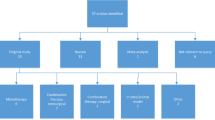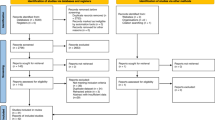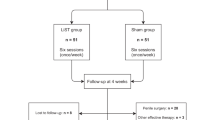Abstract
Non-surgical treatment of Peyronie's disease (PD) has come a long way since it was first described in 1743. A myriad of treatment options are currently available, including oral, intralesional and external energy therapies. The purpose of this article is to review the contemporary literature on non-surgical therapies for PD, and where possible, focus on randomized, placebo-controlled trials, as well as review the latest guidelines for the management of PD from the International Committee on Sexual Medicine, which conveyed its findings in July 2009. At this time, it appears that a combination of oral agents and/or intralesional injection with traction therapy may provide a synergy between the chemical effects of the drugs and the mechanical effects of traction. Until a reliable treatment emerges, it does appear that some of the non-surgical treatments discussed can be used to stabilize the scarring process and may result in some reduction of deformity with improved sexual function.
This is a preview of subscription content, access via your institution
Access options
Subscribe to this journal
Receive 8 print issues and online access
$259.00 per year
only $32.38 per issue
Buy this article
- Purchase on Springer Link
- Instant access to full article PDF
Prices may be subject to local taxes which are calculated during checkout
Similar content being viewed by others
References
de La Peyronie F . Sur quelques obstaclesqui sópposent à l'éjaculation nautrelle de la semence. Mem Acad Royale Chir 1743; 1: 337–342.
El-Sakka AI, Hassoba HM, Chui RM, Bhatnagar RS, Dahiya R, Lue TF . An animal model of Peyronie's like condition associated with an increase of transforming growth factor beta mRNA and protein expression. J Urol 1997; 158: 2284–2290.
El-Sakka AI, Hassoba HM, Pillarisetty RJ, Dahiya R, Lue TF . Peyronie's disease is associated with an increase in transforming growth factor-beta protein expression. J Urol 1997; 158: 1391–1394.
Mulhall JP, Anderson MS, Lubrano T, Shankey TV . Peyronie's disease cell culture models: phenotypic, genotypic and functional analyses. Int J Impot Res 2002; 14: 397–405.
Nachtsheim DA, Rearden A . Peyronie's disease is associated with an HLA class II antigen, HLA-DQ5, implying an autoimmune etiology. J Urol 1996; 156: 1330–1334.
Schiavino D, Sasso F, Nucera E, Alcini E, Gulino G, Milani A et al. Immunologic findings in Peyronie's disease: a controlled study. Urology 1997; 50: 764–768.
Cantini LP, Ferrini MG, Vernet D, Magee TR, Qian A, Gelfand RA et al. Profibrotic role of myostatin in Peyronie's disease. J Sex Med 2008; 5: 1607–1622.
Ryu JK, Piao S, Shin HY, Choi MJ, Zhang LW, Jin HR et al. IN-1130, a novel transforming growth factor-beta type I receptor kinase (activin receptor-like kinase inhibitor, promotes regression of fibrotic plaque and corrects penile curvature in a rat model of Peyronie's disease. J Sex Med 2009; 6: 1284–1296.
Del Carlo M, Cole AA, Levine LA . Differential calcium independent regulation of matrix metalloproteinases and tissue inhibitors of matrix metalloproteinases by interleukin-1beta and transforming growth factor-beta in Peyronie's plaque fibroblasts. J Urol 2008; 179: 2447–2455.
Deveci S, Hopps CV, O'Brien K, Parker M, Guhring P, Mulhall JP . Defining the clinical characteristics of Peyronie's disease in young men. J Sex Med 2007; 4: 485–490.
Furlow WL, Swenson Jr HE, Lee RE . Peyronie's disease: a study of its natural history and treatment with orthovoltage radiotherapy. J Urol 1975; 114: 69–71.
Gelbard MK, Dorey F, James K . The natural history of Peyronie's disease. J Urol 1990; 144: 1376–1379.
Deveci S, Hopps CV, O'Brien K, Parker M, Guhring P, Mulhall JP . A retrospective review of 307 men with Peyronie's disease. J Urol 2002; 168: 1075–1079.
Ralph D, Gonzalez-Cadavid N, Mirone V, Perovic S, Sohn M, Usta M et al. The management of Peyronie's disease: evidence-based 2010 guidelines. J Sex Med 2010; 7: 2359–2374.
Shindel AW, Lin G, Ning H, Banie L, Huang YC, Liu G et al. Pentoxifylline attenuates transforming growth factor-β1-stimulated collagen deposition and elastogenesis in human tunica albuginea-derived fibroblasts part 1: impact on extracellular matrix. J Sex Med 2010; 7: 2077–2085.
Lin G, Shindel AW, Banie L, Ning H, Huang YC, Liu G et al. Pentoxifylline attenuates transforming growth factor-beta1-stimulated elastogenesis in human tunica albuginea-derived fibroblasts part 2: interference in a TGF-beta1/Smad-dependent mechanism and downregulation of AAT1. J Sex Med 2010; 7: 1787–1797.
Safarinejad MR, Asgari MA, Hosseini SY, Dadkhah F . A double-blind placebo-controlled study of the efficacy and safety of pentoxifylline in early chronic Peyronie's disease. BJU Int 2010; 106: 240–248.
Althof SE, Corty EW, Levine SB . EDITS: development of questionnaires for evaluating satisfaction with treatments for erectile dysfunction. Urology 1999; 53: 793–799.
Zarafonetis CJ, Horrax TM . Treatment of Peyronie's disease with potassium para-aminobenzoate (Potaba®). J Urol 1959; 81: 770–772.
Griffiths MR, Priestley GC . A comparison of morphoea and lichen sclerosus et atrophicus in vitro: the effects of para-aminobenzoate on skin fibroblasts. Acta Derm Venereol 1992; 72: 15–18.
Weidner W, Schroeder-Printzen I, Rudnick J . Randomized prospective placebo controlled therapy of Peyronie's disease (IPP) with Potaba (aminobenzoate potassium). J Urol 1999; 6: 205.
Weidner W, Hauck EW, Schnitker J . Peyronie's Disease Study Group of Andrological Group of German Urologists. Potassium paraaminobenzoate (Potaba) in the treatment of Peyronie's disease: a prospective, placebo-controlled, randomized study. Eur Urol 2005; 47: 530–536.
Furst DE, Munster T . Nonsteroidal anti-inflammatory drugs, disease-modifying antirheumatic drugs, nonopioid analgesics & drugs used in gout. In: Bertram G (ed). Basic and Clinical Pharmacology. Katzung Lange: New York, 2001.
Kadioglu A, Tefekli A, Koksal T, Usta M, Erol H . Treatment of Peyronie's disease with oral colchicine: long term results and predictive parameters of successful outcome. Int J Impot Res 2000; 12: 169–175.
Akkus E, Carrier S, Rehman J, Breza J, Kadioglu A, Lue TF . Is colchicine effective in Peyronie's disease? A pilot study. Urology 1994; 44: 291–295.
Safarinejad MR . Therapeutic effects of colchicine in the management of Peyronie's disease: a randomized double-blind, placebo-controlled study. Int J Impot Res 2004; 16: 238–243.
Ralph DJ, Brooks MD, Bottazzo GF, Pryor JP . The treatment of Peyronie's disease with tamoxifen. Br J Urol 1992; 70: 648–651.
Colletta AA, Wakefield LM, Howell FV, van Roozendaal KE, Danielpour D, Ebbs SR et al. Anti-oestrogens induce the secretion of active transforming growth factor beta from human fetal fibroblasts. Br J Cancer 1990; 62: 405–409.
Teloken C, Rhoden EL, Grazziotin TM, Ros CT, Sogari PR, Souto CA . Tamoxifen versus placebo in the treatment of Peyronie's disease. J Urol 1999; 162: 2003–2005.
Biagiotti G, Cavallini G . Acetyl-L-carnitine vs tamoxifen in the oral therapy of Peyronie's disease: a preliminary report. BJU Int 2001; 88: 63–67.
Safarinejad MR, Hosseini SY, Kolahi AA . Comparison of vitamin E and propionyl-L-carnitine, separately or in combination, in patients with early chronic Peyronie's disease: a double-blind, placebo controlled, randomized study. J Urol 2007; 178 (4 Pt 1): 1398–1403.
Scott WW, Scardino PL . A new concept in the treatment of Peyronie's disease. South Med J 1948; 41: 173–177.
Sikka SC, Hellstrom WJ . Role of oxidative stress and antioxidants in Peyronie's disease. Int J Impot Res 2002; 14: 353–360.
Pryor JP, Farell CF . Controlled clinical trial of Vitamin E in Peyronie's Disease. Prog Reprod Biol 1983; 9: 41–45.
Safarinejad MR, Hosseini SY, Kolahi AA . Comparison of vitamin E and propionyl-L-carnitine, separately or in combination, in patients with early chronic Peyronie's disease: a double-blind, placebo controlled, randomized study. J Urol 2007; 178 (4 Pt 1): 1398–1403.
Brown BG, Zhao XQ, Chait A, Fisher LD, Cheung MC, Morse JS et al. Simvastatin and niacin, antioxidant vitamins, or the combination for the prevention of coronary disease. N Engl J Med 2001; 345: 1583–1592.
Fesler MJ, Becker-Koepke S, Di Bisceglie AM, Petruska PJ . Procarbazine-induced hepatotoxicity: case report and review of the literature. Pharmacotherapy 2010; 30: 540.
Bystrom J . Induration penis plastica: experience of treatment with procarbazine natulan. Scand J Urol Nephrol 1976; 10: 21–25.
Morgan RJ, Pryor JP . Procarbazine (natulan) in the treatment of Peyronie's disease. Br J Urol 1978; 50: 111–113.
Armand JP, Ribrag V, Harroussequ JL, Abrey L . Reappriasal of the use of procarbazine in the treatment of lymphomas and brain tumors. Ther Clin Risk Manag 2007; 3: 213–224.
Roth M, Eickelberg O, Kohler E, Erne P, Block LH . Ca2+ channel blockers modulate metabolism of collagens within the extra-cellular matrix. Proc Natl Acad Sci USA 1996; 93: 5478–5482.
Mulhall JP, Anderson MS, Lubrano T, Shankey TV . Peyronie's disease cell culture models: phenotypic, genotypic and functional analyses. Int J Impot Res 2002; 14: 397–405.
Levine LA, Merrick PF, Lee RC . Intralesional verapamil injection for the treatment of Peyronie's disease. J Urol 1994; 151: 1522–1524.
Levine LA . Treatment of Peyronie's disease with intralesional verapamil injection. J Urol 1997; 158: 1395–1399.
Levine LA, Goldman KE, Greenfield JM . Experience with intraplaque injection of verapamil for Peyronie's disease. J Urol 2002; 168: 621–625.
Bennett NE, Guhring P, Mulhall JP . Intralesional verapamil prevents the progression of Peyronie's disease. Urology 2007; 69: 1181–1184.
Mulhall JP, Schiff J, Guhring P . An analysis of the natural history of Peyronie's disease. J Urol 2006; 175: 2115–2118.
Rehman J, Benet A, Melman A . Use of intralesional verapamil to dissolve Peyronie's disease plaque: a long-term single-blind study. Urology 1998; 51: 620–626. 69: 1181–4.
Shirazi M, Haghpanah AR, Badiee M, Afrasiabi MA, Haghpanah S . Effect of intralesional verapamil for treatment of Peyronie's disease: a randomized single-blind, placebo-controlled study. S Int Urol Nephrol 2009; 41: 467–471.
Soh J, Kawauchi A, Kanemitsu N, Naya Y, Ochiai A, Naitoh Y et al. Nicardipine vs. saline injection as treatment for Peyronie's disease: a prospective, randomized, single-blind trial. J Sex Med 2010; 7: 3743–3749.
Duncan MR, Berman B, Nseyo UO . Regulation of the proliferation and biosynthetic activities of cultured human Peyronie's disease fibroblasts by interferons-alpha, -beta and -gamma. Scand J Urol Nephrol 1991; 25: 89–94.
Wegner HE, Andreson R, Knipsel HH, Miller K . Treatment of Peyronie's disease with local interferon-alpha-2b. Eur Urol 1995; 28: 236–240.
Wegner HE, Andresen R, Knipsel HH, Miller K . Local inter-feron-alpha 2b is not an effective treatment in early-stage Peyronie's disease. Eur Urol 1997; 32: 190–193.
Hellstrom WJ, Kendirci M, Matern R, Cockerham Y, Myers L, Sikka SC et al. Single-blind, multicenter placebo-controlled parallel study to asses the safety and efficacy of intralesional interferon alpha-2B for minimally invasive treatment for Peyronie's disease. J Urol 2006; 176: 394–398.
Inal T, Tokatli Z, Akand M, Ozdiler E, Yaman O . Effect of intralesional interferon-alpha 2b combined with oral vitamin E for treatment of early stage Peyronie's disease: a randomized and prospective study. Urology 2006; 67: 1038.
Gelbard MK, Walsh R, Kaufman JJ . Collagenase for Peyronie's disease experimental studies. Urol Res 1982; 10: 135–140.
Gelbard MK, Linkner A, Kaufman JJ . The use of collagenase in the treatment of Peyronie's disease. J Urol 1985; 134: 280–283.
Jordan GH . The use of intralesional clostridial collagenase injection therapy for Peyronie's disease: a prospective, single-center, non-placebo-controlled study. J Sex Med 2008; 5: 180–187.
Gelbard MK, James K, Riach P, Dorey F . Collagenase vs. placebo in the treatment of Peyronie's disease: a double blind study. J Urol 1993; 149: 56–58.
Glina S, Gelbard MK, Akkus E, Jordan GH, Levine LA . The use of collagenase in the treatment of Peyronie's disease M.K. Gelbard, A. Lindner, and J.J. Kaufman. J Sex Med 2007; 4: 1209–1213.
Taylor FL, Levine LA . Nonsurgical therapy of Peyronie's Disease. Asian J Androl 2008; 10: 79–87.
Bodner H, Howard AH, Kaplan JH . Peyronie's Disease cortisone-hyaluronidase hydrocortisone therapy. Trans West Sect AM Urol Assoc 1953; 20: 32–35.
Winter CC, Khanna R . Peyronie's Disease: results with dermojet injection of dexamethasone. J Urol 1975; 114: 898–900.
Williams G, Green NA . The nonsurgical treatment of Peyronie's Disease. Br J Urol 1980; 52: 392–395.
Dickstein R, Uberoi J, Munarriz R . Severe, disabling, and/or chronic penile pain associated with Peyronie's Disease: management with subcutaneous steroid injection. J Androl 2010; 31: 445–449.
Bartsch G, Menander-Huber KB, Huber W, Marberger H . Orgotein, A new drug for the treatment of Peyronie's Disease. Eur J Rheumatol Inflamm 1981; 4: 250–259.
Gustafson H, Johannsson B, Edsmyr F . Peyronie's Disease: experience of local treatment with orgotein. Eur Urol 1981; 7: 346–348.
Kendirci M, Trost L, Hellstrom WJG . Intralesional treatment of Peyronie's Disease. In: Levine LA (ed). Peyronie's Disease: A Guide to Clinical Management. Humana Pres Inc: Totowa, NJ, 2007, pp 81–92.
Stancik I, Schäfer R, Andrukhova O, Oeser R, Plas E, Pflüger H . Effect of transdermal electromotive drug therapy on fibrogenic cytokine expression in Peyronie's disease. Urology 2009; 74: 566–570.
Greenfield JM, Shah SJ, Levine LA . Verapamil versus saline in electromotive drug administration (EDMA) for Peyronie's disease: a double blind, placebo controlled trial. J Urol 2007; 177: 972–975.
Weiss DS, Kirsner R, Eaglestein WH . Electrical stimulation and wound healing. Arch Dermatol 1990; 126: 222–225.
Di Stasi SM, Giannantoni A, Capelli G, Jannini EA, Virgili G, Storti L et al. Transdermal electromotive administration of verapamil and dexamethasone for Peyronie's disease. BJU Int 2003; 91: 825–829.
Levine LA . Review of current nonsurgical management of Peyronie's disease. Int J Impot Res 2003; 15: S113–S120.
Hauck EW, Altinkilic BM, Ludwig M, Ludecke G, Schroeder-Printzen I, Arens C et al. Extracorporeal shock wave therapy in the treatment of Peyronie's disease. First results of a case-controlled approach. Eur Urol 2000; 38: 663–670.
Palmieri A, Imbimbo C, Longo N, Fusco F, Verze P, Mangiapia F et al. A first prospective, randomized, double-blind, placebo-controlled clinical trial evaluating extracorporeal shock wave therapy for the treatment of Peyronie's disease. Eur Urol 2009; 56: 363–369.
Alenghat FJ, Ingber DE . Mechanotransduction: all signals point to cytoskeleton, matrix, and integrins. Sci STKE 2002; 2002: PE6.
Alman BA, Naber SP, Terek RM, Jiranek WA, Goldberg MJ, Wolfe HJ . Platelet-derived growth factor in fibrous musculoskeletal disorders: a study of pathologic tissue sections and in vitro primary cell cultures. J Orthop Res 1995; 13: 67–77.
Brighton CT, Fisher Jr JR, Levine SE, Corsetty JR, Reilly T, Landsman AS et al. The biochemical pathway mediating the proliferative response of bone cells to a mechanical stimulus. J Bone Joint Surg AM 1996; 78: 1337–1347.
Molea G, Schonauer F, Blasi F . Progressive skin extension: clinical and histological evaluation of a modified procedure using Kirschner wires. Br J Plast Surg 1999; 52: 205–208.
Shapiro F . Bone development and its relation to fracture repair. The role of mesenchymal osteoblasts and surface osteoblasts. Eur Cell Mater 2008; 15: 53–76.
Fong KD, Trindade MC, Wang Z, Nacamuli RP, Pham H, Fang TD et al. Microarray analysis of mechanical shear effects on flexor tendon cells. Plast Reconstr Surg 2005; 116: 1393–1404.
Levine LA, Newell MM . FastSize Medical Extender for the treatment of Peyronie's disease. Expert Rev Med Devices 2008; 5: 305–310.
Gontero P, Di Marco M, Giubilei G, Bartoletti R, Pappagallo G, Tizzani A et al. Use of penile extender device in the treatment of penile curvature as a result of Peyronie's disease. Results of a phase II prospective study. J Sex Med 2009; 6: 558–566.
Greenfield JM . Penile traction therapy in Peyronie's disease. F1000 Med Rep 2009; 1. pii: 37.
Abern MR, Levine LA . Intralesional verapamil injections with and without penile traction and oral therapies for management of Peyronie's disease. J Urol 2008; 179 (Suppl 4): 408.
Trost LW, Gur S, Hellstrom WJ . Pharmacological management of Peyronie's disease. Drugs 2007; 67: 527–545.
Author information
Authors and Affiliations
Corresponding author
Ethics declarations
Competing interests
Laurence A Levine, Auxilium consultant, investigator, speaker; AMS consultant, speaker; Coloplast consultant, speaker; US Physiomed consultant; Pfizer consultant; Slate pharmaceutical consultant. Stephen M Larsen declare no conflict of interest.
Rights and permissions
About this article
Cite this article
Larsen, S., Levine, L. Review of non-surgical treatment options for Peyronie's Disease. Int J Impot Res 24, 1–10 (2012). https://doi.org/10.1038/ijir.2011.45
Received:
Revised:
Accepted:
Published:
Issue Date:
DOI: https://doi.org/10.1038/ijir.2011.45
Keywords
This article is cited by
-
Safety and feasibility of percutaneous needle tunneling with platelet-rich plasma injections for Peyronie’s disease in the outpatient setting: a pilot study
International Journal of Impotence Research (2024)
-
A systematic review of non-surgical management in Peyronieʼs disease
International Journal of Impotence Research (2023)
-
Contemporary Review of Peyronie’s Disease Treatment
Current Urology Reports (2018)
-
Aktuelle Therapie der Induratio penis plastica (IPP)
Der Urologe (2018)
-
Tunical Incision Techniques for Peyronie’s Disease
Current Sexual Health Reports (2017)



